T he L o op


THE


In this issue:
• THCI & THMCI Prep Cards - by Rick Williams
Fly Casting Instruction Featured Collection - by Surtees and Shaw:
• Leaning into Learning
• Framing and Priming
• Coach Class
• Head Banger ... and more
1
JOURNAL OF FLY CASTING PROFESSIONALS FALL 2021
Cover photo: Christopher Rownes MCI demonstrates how to execute single hand spey casting at the Fly Casting Master Class at River Lenne, Hagen, Germany on 16th of October 2021
Photo by: Juergen Friesenhahn MCI, co-presenter at the Masterclass
In this Issue
I am writing this shortly after returning from a successful FFI instructor testing event held at the Golden Gate Casting Club (GGCB). As an examiner, I am very impressed by the level on instructor training that is ongoing at GGCP and throughout the Casting Instructor Certification Program (CICP).
Instructor development and training, however, is not a one-time event. It should be an ongoing process for all who teach fly casting. Through the years, The Loop has published many excellent articles on casting instruction. This issue contains a featured collection of articles by Mark Surtees and Will Shaw
on fly casting instruction that will stimulate your thinking about the best ways to teach fly casting.
I hope you will take the time to read the articles and reflect on your own journey as a fly caster and flycasting instructor.
In addition, the issue has an article by Rick Williams that provides very helpful practice cards for the two new two-hand casting instructor (THCI and THMCI) exams.
Jim Wigington, Editor-in-Chief
WANTED
We’re calling for article ideas from all CICP members, all casting instructors, and all fly fishing photographers worldwide.
Please email your ideas and photos to: loop@flyfishersinternational.org

2 THCI Prep Cards P.3 Cues and Sensory Feedback P.15 IN THIS ISSUE Leaning into Learning P.9 New Registered Instructors P.32 Not That Special P.10 Editorial Team P.33 Contact Us
P.21 Coach Class P.18 Framing and Priming P.27 Head Banger Fly Casting Instruction
Col
THE LOOP, FALL 2021
Fly Casting Instruction Featured Collection
Featured
lection
Preparing for Two-Hand Exams – THCI & THMCI Study Cards
• THCI Study Cards: Cast Descriptions and THCI Exam tasks
• THMCI Study Cards: Cast Descriptions and THMCI Exam tasks
By Rick Williams
In this article, I present newly developed study aides for the new THCI and THMCI Exams. The two new TH exams were approved by the CBOG in 2020, introduced in January 2021, and described in the May 2021 issue of The Loop. Below, are instructions on how to create a set of waterproof cards as an on-water study aid for candidates preparing for the new THCI Exam or the newly updated THMCI Exam. Each card deck contains all of the casting performance, teaching, and fault diagnosis/correction tasks required for the THCI and THMCI exams, respectively, as well as guidelines and diagrams for anchor positions.
This effort arose out of a 2009 article I wrote for the spring issue of The Loop, in which I shared with CICP instructors, directions on how to create a set of waterproof cards that listed all of the performance tasks for the THCI exam at that time. I developed the cards in 2006 as a study aid for myself while working toward my THCI Instructor certification.
The cards were an alternative to carrying a printed (and often wet and soggy) copy of the THCI exam stuffed in my waders as a reference tool while I was on the water practicing all the various TH performance tasks. The old THCI test had many casting performance tasks, with some that differ only slightly from one another, such as a change in casting angle from 45 degrees to 90 degrees. Consequently, it was
often hard to remember (and practice) all the various THCI casts. Having the waterproof THCI Card Deck as an on-stream reference aided the quality of my practice time.
Since sharing the THCI Study Cards and how to make them in the 2009 Loop article, I’ve heard from many THCI instructors and students how useful the cards were in their own journey toward THCI certification. Over the last decade, I’ve been shown copies of the cards in North America, the UK, and Japan while traveling to FFI Casting and Certification Events.
With the 2021 launch of the CICP’s new TH program that includes an entry level THCI Exam (similar in scope and scale to the single hand CI exam), as well as an update/upgrade of the previous THCI exam into the new THMCI Exam, I decided to update the 2009 THCI Study Cards into a THMCI Study Card deck, and to produce a companion THCI Study Card deck to assist CICP instructors and candidates as they prepare for either of the TH exams.
The information is presented in two accompanying PDF files that can be downloaded and printed as the first step in developing your own THCI or THMCI Study Card deck. Representative pages are shown to illustrate the two files and the finished card deck.
3
THE LOOP, FALL 2021
THCI and THMCI Study Cards
continued ...
THCI Study Cards: Cast Descriptions and THCI Performance, Teaching, and Fault Correction Tasks
The purpose of this file is to create a waterproof set of cards for the THCI Exam to take on the river as a self-teaching and practice aid.
The completed card deck consists of fourteen waterproof cards. For the various casts, each card has a ‘How To’ cast description on one side, and on the other side, a complete list of all the related THCI exam performance tasks. Notice in the photo that the cards are attached to a lanyard, so they can wear them around your neck and tucked into your waders while practicing casts and THCI tasks. To reduce the bulk of the card deck, consider printing the file, then creating two decks: one with the Performance casts; and a second with the Teaching and Fault Correction tasks.
The Waterproof Card Deck slide (above right and in the accompanying PDF) gives instructions on how to print the cards and turn them into a waterproof card deck. The hardest part of making the cards (and it’s not hard!) is taking the paired back-to-back cards to an office supply store and having the cards laminated in clear plastic laminate. Place two cards into each plastic (8.5” x 11”) sleeve and position them so that each card has at least ¼ - ½“ clear margin around it after the lamination occurs. Cut each card out leaving a sealed airtight margin around it of ~½“. Leave extra margin along one side or top edge so that a hole can be punched through and a ring and lanyard placed.
I found having these cards on stream and in my practice kit to be very helpful. I hope you’ll take the time to make a set and use them in your THCI preparation.
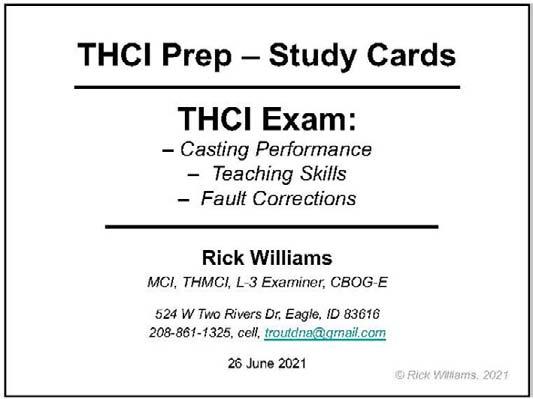
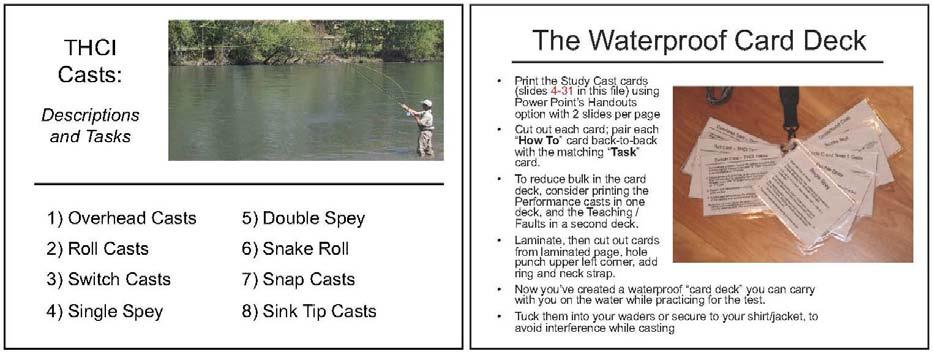
4
LOOP, FALL 2021
THE
Click to download the THCI STUDY CARDS
THE LOOP, FALL 2021
THCI and THMCI Study Cards continued ...
Examples of the ‘How To’ card and its corresponding THCI Task card are presented on the right for the Switch Cast in the THCI Performance Section 1A.

Examples of cards for THCI Performance Section 1C Sink Tips Tasks and for the THCI Teaching Section Task 1.

5
THCI and THMCI Study Cards continued ...
THMCI Study Cards: Cast Descriptions and THMCI Performance, Teaching, and Fault Correction Tasks
The purpose of this file was to create a waterproof set of cards for the THMCI Exam to take on the river as a self-teaching and practice aid.
The completed deck of cards consists of fourteen waterproof cards. For the various casts, each card has a ‘How To’ cast description on one side, and on the other side, a complete list of all the related THCI exam performance tasks. Notice in the photo that the cards are attached to a lanyard, so they can wear them around your neck and tucked into your waders while practicing casts and THMCI tasks. To reduce the bulk of the card deck, consider printing the file, then creating two decks: one with the Performance casts; and a second with the Teaching and Fault Diagnosis Correction tasks.
Click to download the THMCI STUDY CARDS
Examples of the ‘How To’ card and its corresponding THMCI Task card are presented below for the THMCI Single Spey Cast.

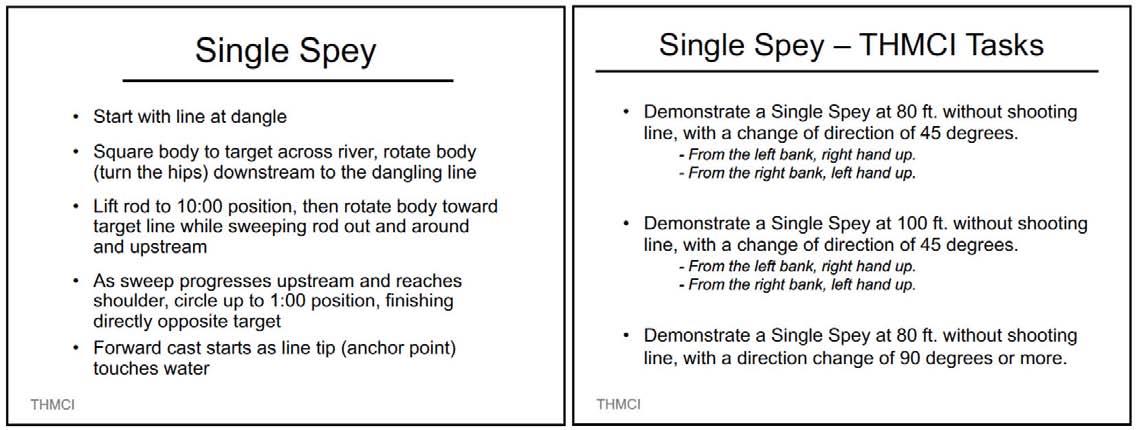
6
THE LOOP, FALL 2021
THE LOOP, FALL 2021
THCI and THMCI Study Cards continued ...
The study cards for THMCI Sink Tip Performance Tasks, and Oral Questions about Shooting Heads.

The study cards for THMCI Teaching Performance Task 1, and the THMCI Fault Demonstration and Correction Task 1.
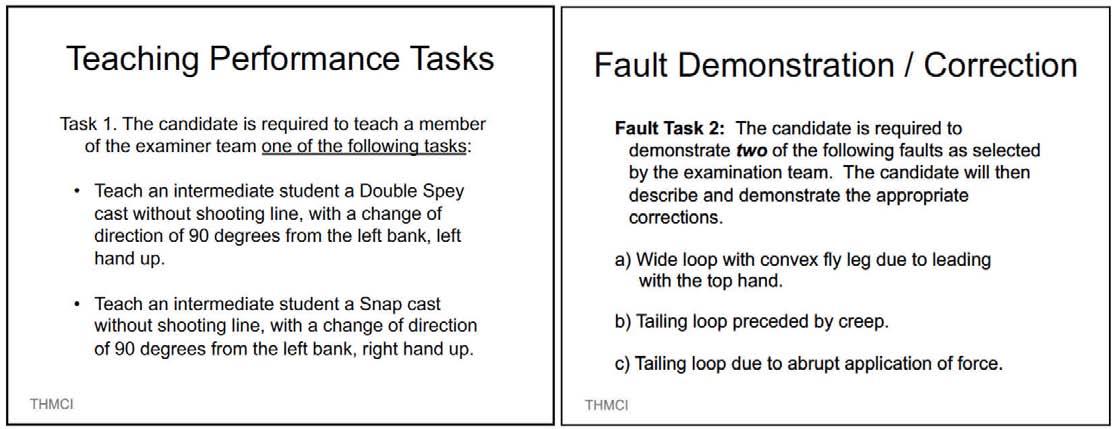
7
THE LOOP, FALL 2021
THCI and THMCI Study Cards continued ...
Study cards for Anchor Position Guidelines and Anchor Placement Diagrams are included at the end of both THCI and THMCI Study Card decks.
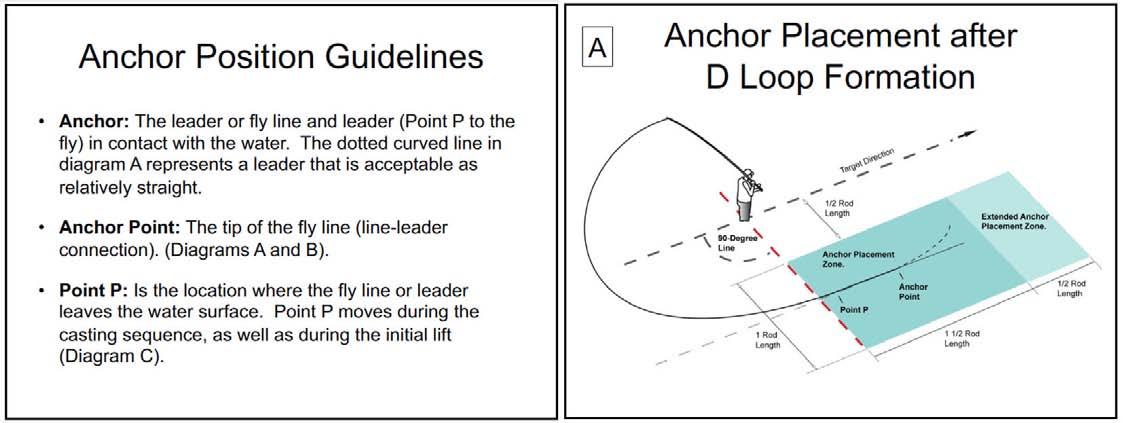
Good luck on the journey toward Two-Hand Instructor Certification. It can be a richly rewarding odyssey fraught occasionally with difficulty and frustration, moments of giddy excitement when something finally works, or glorious epiphanies when you finally “get” some important concept. Most rewarding of all, will be the astonishing generosity you will experience from fellow instructors and two-hand casters of their time and expertise for your benefit.
ACKNOWLEGDMENT
I’d like to acknowledge the invaluable mentorship and friendships of Simon Gawesworth, Mel Krieger, Ally Gowans, and Al Buhr; all integral to my development as a two-hand caster and instructor. Greg Pearson generously loaned his casting illustrations used in Simon’s wonderful books.
Finally, I thank fellow THMCIs Molly Semenik, Willie Holmes, Todd Somsel, Thomas Berggren, and Bruce Williams for providing constructive input on the development of the THCI and THMCI Study Cards.
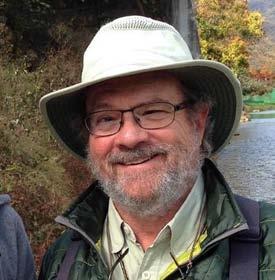
Rick Williams (MCI, THMCI, L3 Examiner, CBOG-E) lives in Eagle, Idaho with his favorite fishing companions, wife Shauna (CI), and Labrador Retriever Kyoko.
8
INDEX
LEANING INTO LEARNING
By Will Shaw and Mark Surtees
Whenever and wherever instructors gather you will hear stories of “nightmare students” who “just could not get it” or who “were sorted by the end of the lesson” but who came back a week later and “were right back where they started”. Often people don’t follow instructions like “stop the rod!” or “less power!” Frequently people don’t get our carefully drafted analogies such as, “grip the rod like you’re holding a small bird!”, “throw that dart!” or “hammer that nail!”.
Interestingly these stories are almost always whispered in a bar confessional, with close friends and confidantes. To the wider world our public face is one of confident infallibility. We can sort you out in 10 minutes and you’ll be hitting the horizon with every kind of cast you can imagine! No problem.
As two distinctly fallible instructors this strikes us both as slightly odd. These difficult students seem to appear with such monotonous regularity that it begs the question, “Is it them or is it us?”. Our understanding of fly casting has come a long way in the last 20 years. We have some fantastic studies on the physics and biomechanics of fly casting. There may still be some areas of uncertainty but we do have great models to help us understand the various ingredients that go to make a good cast. And yet…
The methods we use to teach fly casting have not really evolved in parallel with our gains in understanding of the physics and mechanics.
We are (mostly) limited to basic teaching models such as:
• Introduce
• Demonstrate
• Explain
• Attend to the learner practicing the skill.
Instruction in this model is often focused on explicit commands relating to hand/arm/body/rod movement ; e.g. “place your feet like this”, “move your hand from here to here”, “do/don’t open/close your wrist”, “loosen your grip”, “do this” or “don’t do that”.
There’s a tendency in flyfishing and instructing, to adopt a “my way or the highway” approach, and to imply, or sometimes state outright, that if you don’t agree then you’re an idiot who shouldn’t be trusted with a cane pole never mind a fly rod. We hope to avoid this by describing in this series of articles some of the developments in wider sports coaching and instruction and in the theories and practice of learning, which we use regularly in our own instruction. By doing this we aim to stimulate a debate amongst instructors as to how best to develop and improve the way we teach and coach fly casting. In the end we believe that by adopting teaching methods which are effective in other sporting disciplines we will improve the results of our teaching and give learners more satisfaction and enjoyment when they fish.
We start with a disclaimer. We do not claim any level of qualification or particular expertise in the field of cognitive psychology. We are, however, practised (over a combined 20+ years) in the same ideas and models for teaching fly casting that everyone else uses because we both came through the same process as every other qualified instructor (variously: FFI, AAPGAI, SGAIC, UKCC).
9
THE LOOP, FALL 2021
INDEX
NOT THAT SPECIAL
Why learning to cast is like playing the bassoon
By Mark Surtees and Will Shaw
All organisations involved in casting instruction work hard to produce highly motivated, skilled and knowledgeable people. Assessment curricula direct candidate effort towards being able to explain and demonstrate top quality casting and to analyse and correct casting faults.
Without exception, instructor candidates are committed to becoming better casters and teachers and most start from a position of considerable angling experience. In contrast, for the vast majority, there is little or no instruction experience. Entirely unavoidably perhaps, all certifying organisations produce expert, well-informed casters who are novice instructors.
Of course, a newly qualified instructor has more than enough in the bank to get going but, like so many instructors we have talked to, we do not teach now the way we taught ten years ago. We have all changed since that first assessment…why ?
Every single instructor we have discussed this with describes common features, they all explain less, deliver less information and spend more time encouraging their students to try and think out solutions for themselves. This is in contrast with our early lessons where all we want to do is explain to our students how it all works and solve their problems for them super quick with our ready-made textbook fixes.
The “information content”, what we teach in the form of facts, concepts and ideas about casting, is not the focus of this piece. Nor are we too closely interested in the outputs or products of our instruction, the casts. That these things are critical in delivery of a lesson is not in question, but in this series of articles we are going to explore some fundamental concepts of motor skills acquisition that we believe may be of value to new casting instructors.
Neither of us are experts in cognitive psychology but we have tried to explore what we have changed, and why we have changed it, and whether this has made our instruction more, or less, effective. Most of the research backing these articles is available with a superficial Google search. We have included key academic references where appropriate. In addition, The Loop articles by Dayle Mazzarella in 2012 more than adequately cover many key concepts and some of these were re-addressed in FFI Professional Development Committee (PDC) in 2016.
To begin, we have to clarify some basics. The first may come as something of a shock.
1. Teaching fly casting is not that special.
Please relax. The output, casting in all its variations, is very special but, to produce this output, at root, you are teaching people how
10
THE LOOP, FALL 2021
Not That Special
continued ...
to move. Thankfully, on this basis, playing the bassoon isn’t so special either…neither is golf…so it’s not all bad.
Teaching movement is a common multi-disciplinary process and the principles behind how people learn to move are also, pretty much, common. Casters, like bassoon players, or golfers, develop their skills something like Figure 1.
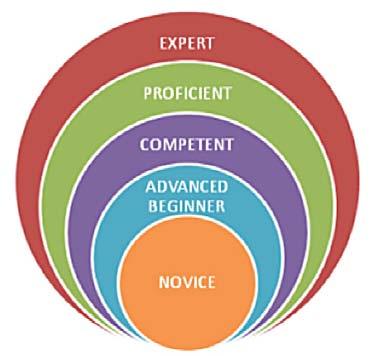
It’s obvious isn’t it ? But what isn’t so obvious is that this significantly influences not just what we teach but how we teach it. From the mid-twentieth century, vast academic resources have been applied to understanding how people learn and move through these developmental stages.
Thousands of research papers have been written on the efficacy (or not) of different approaches to skill acquisition in sport, how to encourage goal-oriented learning and papers that explain why, what we say, when we say it and how we say it, influences the results of our lessons.
If our objective in instruction is to match, as closely as possible, how we teach to how people learn, all of these researchers assume one thing…learning happens in the brain.
2. The challenges we face as instructors are overwhelmingly psychological not physiological.
Human physiology plays its part of course but, whilst you may occasionally feel like you’re talking to somebody’s foot, you are principally interreacting with the brain. It’s rarely a physiological incapacity that holds us back in casting; it’s our resisting brains. If you can stimulate someone’s brain into believing it’s a good idea to do something, the body will usually co-operate…usually.
In doing this it is important that we recognise one well-proven fact.
3. People learn motor skills differently to the way they learn facts, concepts and ideas (Bloom et al. 1956).
We know from extensive academic research going back to the 1950s that teaching someone about something, giving them information, is not at all the same as teaching someone how to do something. Bloom’s research identified three different learning domains, see figure 2
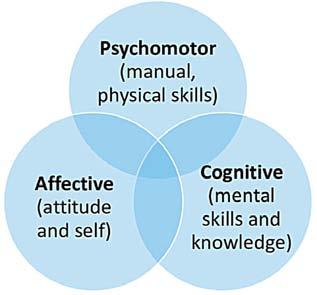
Each one is different but this does not mean that an instructor shouldn’t teach people facts, concepts and ideas, only that this kind of content may not have any meaningful effect on how your student ultimately casts.
Some concepts of learning preference, Visual, Auditory, Kinesthetic (VAK), Visual Auditory,
11
THE LOOP, FALL 2021
Figure 1. Benner’s novice to expert (Benner 2017)
Figure 2. Bloom’s learning domains (McKenzie et al. 2017).
Not That Special
continued ...
Reading Kinesthetic (VARK), etc. have influenced casting instruction. Their value has been, and continues to be, widely disputed in educational psychology circles (Pashler et al. 2008). In the case of casting instruction, their relevance is highly debatable because, in fact, motor skills are learned in only one way.
4. Motor skills are learned by repetitive practice linked to a sensory cue.
Very simple. We can read about it, hear about it, watch as many online tuition videos as we like…they all help in their way but, we’re only going to learn by doing it over and over (Bloom et al. 1956).
A sensory cue is a feedback mechanism that gives us an indication that we may need to modify our behaviour if we want to succeed at something. For fans of VAK, all is not entirely lost because by sensory cue we mean something which we can see, hear, feel, smell or taste. A visual, auditory or kinesthetic clue by which we can measure success or failure in meeting an objective.
For any skills acquisition, Practice + Sensory Cue = Learning. This means that cue setting becomes a critical skill for instructors to master. It can make life easy, or it can make it more difficult.
This is because:
5. Given a particular stimulus, people react to it in generally predictable ways.
Almost nobody likes this idea because it implies that we’re not unique and important and that our capacity for independent critical thinking is limited.
Of course everything is layered, but serious objectors to this proven concept would have you believe that they are not affected in any way by advertising, political messaging, sudden loud bangs or road traffic signals. This is possibly true if you are an alien, or my mother (not mutually exclusive). For the rest of us, over 100 years of studies by earthbound neuro-psychologists in university kinesiology and cognitive psychology departments says otherwise. Amongst other things, this explains why Heinz tomato sauce is the number one ketchup in the UK, why we stop at red lights and why we don’t usually hug snakes.
This principle works for instructors because, if we can create the right stimuli, we will get predictable responses and this will help a caster learn quickly. The corollary to this of course is that if we use the wrong stimuli we will also get predictable responses and a caster will learn more slowly.
The stages of learning are also predictable. This is enormously important in the management of expectations for instructors and learners alike. It is highly influential in how much an instructor mixes information content with skills instruction, how much an instructor should actively intervene to promote learning and the differing types of cues or stimuli to which a learner will respond.
6. People placed on a continuum of experience learn at different rates. In widely accepted models developed by educational psychologists in the 1960s this continuum of skills acquisition was broken down into three basic stages of learning (Fitts and Posner 1967).
See Figure 3.
12
FALL
THE LOOP,
2021
Not That Special

The first two stages roughly fit with the descriptions of “beginner” or “intermediate” students in the CI test so let’s have a look at what it might mean for an instructor.
a. The Beginner or “Cognitive” stage. This involves a great deal of concentration on the part of a caster but, generally speaking, beginners make large leaps in performance given appropriate prompts. This is a low information, high intervention lesson. It is foundational, where a caster will often achieve positive performance and retained learning very quickly. Both you and they will believe it’s all down to you…you may develop a strut.
Beginners cannot easily “see” the effect of motions as they happen, loops in the air, or tip paths for example. They can, however, easily see the static consequences of motions, leader and line layouts. Techniques that progressively introduce and develop the skill of watching a loop as it unrolls and learning to look both ways during a casting cycle are important at this stage.
It is worth taking great care with beginners in order to ensure that the things they learn are a suitable basis for progressive development at later stages. If the foundations are too rigid, then this could create obstacles to learning in the next stage. If the foundations are built to promote expansion in the next stage, then life down the line, for both instructor and student, becomes a little sunnier.
b. The Intermediate or “Associative” stage. Most of your clients will be functioning anglers operating at this level. Because very few anglers start casting under the guidance of an instructor, intermediate casters are like beginners when it comes to cue observation. They are better, however, at associating a change in movement with a change in outcome.
Intermediate casters make smaller steps in performance and commonly plateau between steps. It also involves significant concentration and its often very hard work for your student. In this stage instructors are most likely to encounter defensive learning postures. Pre-formed excuses for why they believe they cannot easily change. Stepped instruction, with each stage reinforcing the last is important in this phase because it buys you wins. This is where you will do your heavy lifting and where the real instructional heroes live.
c. Experts know it all already…this is the third “Autonomous” stage, you are only there to applaud.
7. Competencies are task specific
Later researchers expanded on this early learning model and added detail to introduce five levels of competence (Dreyfus and Dreyfus 1980).
13
...
continued
THE LOOP, FALL 2021
Figure 3. Three stages of learning (Quinn 2016).
THE LOOP, FALL 2021
Not That Special
continued ...
As shown in Figure 4 below, the level of instructor feedback required as the caster progresses reduces.
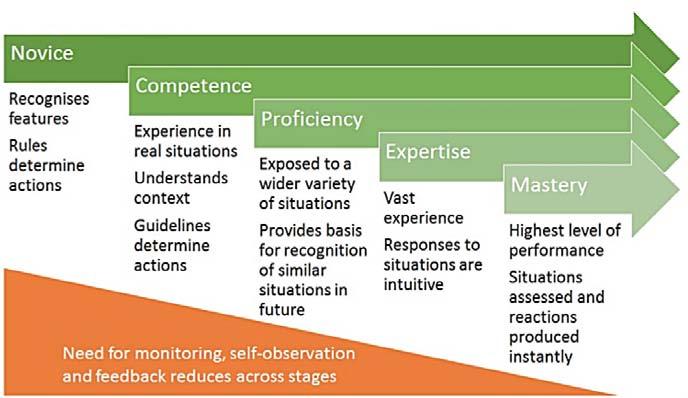
High intervention is necessary at the beginning but poking your nose in at levels four or five is quite likely to earn you a dark beady-eyed stare unless it is specifically requested. Nevertheless, an expert encountering a new technique will still go through the stages described in point #6 above even though they may not spend much time in the first two.
Finally:
8. Performance under supervision is not evidence of learning
When you do get someone doing something, they may not be able to do it again a day later…or even in the same lesson. If you were convinced of your own super-instructor awesomeness at the end of lesson one this can come as something of an ego slam when they
arrive back for lesson two. Some instructors never admit it ever happens at all. Nevertheless, some regression like this is completely normal. We can do a lot to mitigate it but be reassured it’s not a sign of poor teaching, it’s just a sign that you haven’t finished yet. In the next article, we will look at Cueing, how it works and some of the ways we can use it.
References
Benner, P. 2017. Novice to expert nursing theory. (http://novicetoxpertnursingtheory.blogspot.com/).
Bloom, B. S. (ed.). 1956. Taxonomy of educational objectives. Vol. 1: Cognitive Domain.
Dreyfus, S. and H. Dreyfus. 1980. A Five Stage Model of the Mental Activities Involved in Directed Skills Acquisition. 1980. Operations Research Center. University of California, Berkeley.
Fitts, P. and M. Posner. 1967. Human Performance. Brooks/Cole.
McKenzie, E. et al. 2017. Challenge activities for the physical education classroom: affective learning outcomes. Strategies.
Pashler, H. et al. 2008. Learning styles, concepts, and evidence. 2008. Psychological Science in the Public Interest.
Quinn, K. 2016. https://slideplayer.com/slide/12779103/77/images/5/ This+learning+process+consists+of+three+stages.jpg/.
Rogers, R. https://richrtesting.com/the-dreyfus-model-a-visualsummary/.
14
INDEX
Figure 4. The Dreyfus model (Rogers)
CUES and SENSORY FEEDBACK
By Mark Surtees
When experienced casters cast, the choices made about how we are going to move are determined by various factors. Some of those factors would be caster position relative to the objective, usually a fish, the environment (terrain underfoot, trees, bushes, weather conditions, water conditions, etc.), the characteristics of the equipment we are using and lastly by our physiological capacity to control the input elements of the cast. Secondary to these primary influences, we react to continual changes in environmental stimuli such as a shift in wind direction or changing position of the fish, by making micro adjustments to our casting strokes to account for them.
This is sensory feedback at work. Usually we won’t waste a moment giving any thought as to how we must move a hand from here to there or how much more or how much less force we have to apply to the rod to do it. We don’t think about what we have to do to get tip path x or y, we just do it. When we are able to respond to stimuli quickly like this without thinking, it is called Implicit Behaviour. It is smooth and fast, automatic, autonomic or intuitive.
If you’re not so hot with the rod then it’s quite likely you will exhibit some Explicit Behaviour. Compared to near instant, almost reflexive responses, explicit behaviours are relatively slow and often disjointed. When we have a task that is new or complex we have to think carefully about what we are going to do both before and while we do it. Very commonly this causes discontinuities in the process as we stop for fractions of seconds to consider what comes next. We goof up frequently, get frustrated and irritable, and confidence and motivation drops. Explicit behaviour like this is an expected and necessary step in the learning process.
As instructors this is the space in which we do most of our detailed work, the associative stage. We’re trying to smooth out those discontinuities caused as casters deliberating the possible consequences of their actions.
A lesson is an opportunity for an instructor to create an environment where the critical stimuli are controlled. Obviously we can’t control the weather, but almost everything else can be managed to our advantage. If we do this carefully, we can keep motivation high and promote more intuitive reactions.
Sensory cues
A sensory cue is one linked to the five senses, sight, sound, touch, smell and taste. Something that offers a stimulus or sensory feedback that a caster can independently use to assess whether they need to make a change in motion…or not. Whether used directly or discreetly, cues will stimulate predictable responses. So, if you want your caster to do it, you’re going to have to cue it.
Sensory cues can be divided in to two basic types.
1. Externally focused cues
An external cue is used when a student is asked to concentrate on the effect of a body movement. “This is what happens when you do this”.
For us, most external cues are visual, observing a loop shape or a line layout, moving a glass of water without spilling it, or assessing how close your fly lands to a target, even a smile.
15
LOOP, FALL 2021
THE
Cues and Sensory Feedback
continued ...
It may occasionally be auditory, the whoosh, or not, of a rod, the sound of an encouraging word. Analogies, much loved by instructors are external cues.
They are outcome-centric and outward facing.
2. Internally focused cues
An internal cue is used when a student is asked to concentrate on affecting change to a particular part of the body. We see this kind of cueing when instructors focus attention on the wrist when trying to deal with excessive rod rotation or elbow positioning during a casting stroke.
They are body-centric and inward facing.
Research has shown that they operate in a hierarchy (Gabriele Wulf 2007).
“An external focus is not only more effective for performance and learning, compared to an internal focus, but also results in greater movement economy. That is, an external focus appears to speed the learning process so that a higher skill level is achieved sooner.”
This is enough to tell us that, wherever possible, our cues should focus on outcomes, the results of motions rather than the movement of joints, limbs, hands or even feet that are making them. Once again, extensive research has shown that internal focus on a particular body part is more likely to produce discontinuities in explicit behaviours. One bizarre effect of this is that, sometimes, the more we concentrate attention on a wrist for example, the less control the caster is able to exhibit over it.
A cue should offer a mechanism for a caster to self-assess whether they have achieved an objective or not. When you are setting cues,
they must always be portable, something that a caster can learn to react to whether or not an instructor is present. This is because during practice with an effective cue, casters will self-optimise.
Self -optimisation
Given a sensory cue or objective, we will all, beginners and experts alike, optimise our behaviours accordingly. In the first example above, experts use multiple, co-occurring, environmental stimuli as cues to optimise behaviour, if we hit a bush we shorten line and go again. (If we are instructors, we will also look about to make sure nobody saw.)
Self-optimisation is a concept often misunderstood. It does not mean that beginners will eventually miraculously self-discover a hump mend or a double haul or that instructor input is unimportant or unnecessary. It means that, given a creative cue and appropriate support from an instructor, a caster will make incremental adjustments on their cast until they meet their objective without too much further intervention. (Observing a simple cross body drill where the caster is asked to produce a loop which doesn’t fully unroll should be sufficient to demonstrate this effect.)
This is implicit behaviour trying to get out and it pays us to encourage it. Even though the caster may exhibit explicit behaviours in the process, they will learn implicit behaviours faster by working on it and controlling it for themselves.
Be aware also that it is quite possible to produce desirable outputs very quickly with a high intervention strategy; a very attractive option for instructors but which often creates a false sense of success for learners. Fast is not necessarily better. In fact, although it takes a bit longer and quite a bit of restraint on the part of the instructor, transfer to implicit behaviour is often more effectively achieved by
16
LOOP, FALL 2021
THE
THE LOOP, FALL 2021
Cues and Sensory Feedback continued ...
a lower-intervention, cued strategy because this encourages greater engagement in learning by maximising self-optimisation. When we teach, it is very easy to assume that because a learner can produce tidy output under intense supervision our work is complete. In fact, our aim is to help a caster close the time it takes to move between casting in a cognitive, explicit way to casting in an autonomic, implicit way. This is more than someone being able to perform when we coach, it’s ensuring they are able to perform when we don’t coach.
Finding a “student appropriate” cue.
As a basic rule the further along the learning continuum a caster is the more likely they are to be able to tolerate internal cueing. In some contexts internal cueing is unavoidable, even desirable, setting stances for example. It’s worth noting however that, given a choice, it is usually less effective than its external relation.
Complex motor skills like fly casting can be, and often are, broken down into bite-sized pieces for explanation and demonstration. A pickup and laydown for example can be described as a lift, a casting stroke, a pause, a casting stroke and a lay down.
Each part can be vested with purpose; to lift the line from the water, to form a loop, to allow the loop to unroll, etc. This affords an instructor the opportunity to observe and question, “did it form a loop?” “what shape was the loop?” “how might we change the shape of the loop?”, etc. The loop in this way becomes an objective.
For casters who have learned to look, a loop can be a useful cue. The drawback is that it is mobile and transient and they are not in the best
position to observe it. Because casters are operating in that explicit learning space they’re often thinking too hard about making a loop to actually watch it once it appears. Consequently, it may not be an effective cue for someone earlier on the learning continuum. Here we must find a cue with a bit more permanence, leader layout perhaps. “Is the leader straight?” “What can we do to get a straighter leader?”, “Can you make the leader pile?”, etc.
The implications of this for an instructor are quite simple. You must link a sensory cue to the motion you are trying to teach. The cue must reflect the learner’s capacity to sense it and react to it. If you can’t make a useful sensory cue from your concept or idea then dump it because, for motor skills, a functioning cue is way more important for your learner than understanding the abstract idea.
If you do this your lesson will have a greater focus on objective achievement, it will be de-cluttered and therefore much easier both for you to deliver and your learner to understand.
Finally, your words and physiological responses in reaction to a caster’s performance are critical to promoting, reinforcing or even preventing, long term change. During a lesson you too are a cue.
Next, Framing and Priming.
References
Wulf, G. 2007. Attentional focus and motor learning. E-Journal Wewegung und Training.
17
INDEX
FRAMING and PRIMING
By Mark Surtees
Through experience, we are able to predict with reasonable certainty the problematic areas we are most likely to encounter during lessons long before they happen. Narrow control ranges, excess force, over rotation, and body tension for example.
Fishing, for many anglers, is about more than just casting or a catch, kill, eat instinct. There is often a high personal and emotional investment in being good at it. Our clients commonly arrive with what they believe is a catalogue of casting faults, and even for the most open-minded client approaching a lesson, they know that their performance is likely to be critically appraised.
Any CI assessment candidate will have experienced critical appraisal, your self-esteem is under threat, pressure increases and performance levels drop. When a client arrives for a first lesson the anticipation of this kind of low-level stress can generate the faint suspicion that they may be about to undergo the casting equivalent of a dental appointment. Whilst this is plainly irrational and probably does not warrant the level of concern that you may have if confronted by a charging bull moose or discover a rip in your paraglider wing when leaping off an alp, it is still unsettling.
In this delicate condition criticism, however constructive and however much it may have been sought, is not always well-received. This unease is enough to provoke a mildly defensive psychological posture which, whilst probably barely observable to you the instructor, is often sufficient to produce a surprising resistance to change in your client. Why? Because your client, whether they are aware of it or not,
has already begun to employ subconscious coping mechanisms to tune out any esteem-damaging critical noise...”LA, LA, LA...quick... distract...think about weird stuff”.
Under relatively mild pressure we tend to stick to tried and trusted routines, protected by familiarity, cocooned and safe. Weirdly, we may do this and yet believe we have done something radically different when all that has really occurred is that a light shot of stressy adrenaline has made the same thing happen but with some extra oomph. When tension manifests itself physically in a too tight grip, high body rigidity and too much wallop, something must be done.
We know that almost everyone responds better if there is a lean toward a positive focus rather than a negative focus. This alone should guide your lesson away from fault identification and correction because it necessarily involves that critical appraisal.
Before the roar is raised in defence of the Six Steps, this does not mean that the system is any less useful as a mechanism for identifying where you may concentrate your efforts or order your work. Simply, your client doesn’t need to know the horrors you have seen. In fact the six steps is just as valuable in identifying what a client does right as it is for identifying what a client does wrong. As a result it is a vital mechanism for placing your client on the learning continuum.
If we take this assessment of prior learning of a client as a base we can use it to build and expand rather than view it as collection of errors requiring a remedy.
18
THE LOOP, FALL 2021
Framing and Priming
continued ...
By doing this we are using a technique called “Framing”.
Framing is when the behaviours we choose to employ are influenced by the way in which information is presented to us. It is used as a fundamental motivational aid by professional coaches across many sports and is much beloved by marketing and advertising execs to make us more likely to buy their products. It is only words of course but there is a subtle motivational difference between telling someone that you are going to “fix your inappropriate application of force” or “help expand control over your casting stroke”. These motivational effects compound and frame a lesson in the students mind as mechanism for development rather than correction.
In this respect an instructor’s preamble is more than just about investigating experience and expectations or setting objectives. This early introductory period is an opportunity to prepare the ground and make our proposals for change a little more persuasive and easier for a caster to execute later in the lesson.
Closely related to Framing is “Priming”.
The term Priming is used to describe the influence a particular stimulus has on the reaction to a future stimulus or performance. There is a great deal of psychobabble surrounding this concept but there is more than sufficient research and evidence to show how effective it can be when it is properly directed. Priming with words and numbers, creating associative links, and anchoring is common in sales negotiations and various nefarious socio-economic and political contexts.
It works to everyone’s advantage in skills instruction too. If we know
that we want to achieve relaxed, smooth, low-force casting we can use words and mental images throughout a lesson associated with these issues.
Similarly, we are able to identify and therefore avoid words that have the opposite effect. Some of the terms we use on a regular basis, “load” or “acceleration” for example are frequently associated with “more force”, or “faster”, things which we may want to discourage rather than promote. It is fascinating and revelatory to attempt to conduct a lesson without them.
Less obvious perhaps is priming with “sensory cues”. This is a mechanism that stimulates desirable behaviours before we have to directly address undesirable ones later in the programme. If we get this right it reduces the chances that we may have to later resort to instruction with an internal focus to remedy a particular problem. We achieve this by using a cue which establishes a sensory benchmark for future reference before a caster works with rod in hand.
A sensory reference here is critical. Some techniques involve asking a caster to imagine something similar to whatever it is we are trying to achieve. Analogies are a type of external cue in their own right, “imagine holding a small bird” to reduce grip force for example or “imagine running your rod along a shelf” to encourage a long casting stroke or a straighter hand path. Even though they have an external focus, in this form, they are abstract and distant with no sensory feedback.
Mundane cues that generate an actual sensory response, “please hold this tomato” or, “please pass me the water glass” are more effective in pre-establishing control parameters because they are real and recent.
19
FALL
THE LOOP,
2021
Framing and Priming
continued ...
By doing this, you already have your caster doing something they can use to learn. Once created they can be used as analogy later in the lesson. As a general rule of thumb, if you have an option of real over imaginary, go real. While your caster may never be quite sure whether they have crushed the life out of an imaginary chaffinch they’ will definitely know if they’ve got an actual fistful of squished tomato.
This is not to say that remote analogies don’t work, a show demo without an imaginative and entertaining analogy isn’t going to be much good. It adds colour in one-to-one instruction too; I love them and they too can be a form of priming with words.
Whether priming or directly cueing we can exploit autonomic skills that a caster can already do, motions that are part of their prior knowledge. These motions may be similar or even the same as those needed for learning or improving a casting cycle and there’s no point wasting time trying to teach someone to do something they already do in their normal daily lives.
For wrist management, for example, we can be sure that if asked, a caster will pass a full coffee cup or water bottle to you with complete control over their wrist. This kind of control is more than adequate for the management of a fly rod. Despite this, once rod is in hand their wrist will be moved as if they were waving their kids off on the Titanic because that is what they “believe” they must do to make it work.
Without any prior priming, focus on the wrist from an instructor will usually make matters worse. You’ve delicately pointed out that they don’t want to do it … but they’re doing it anyway. Why? Because desirable behaviour and entrenched belief are in conflict. Now the caster enters a state of dissonance in an explicit learning process,
internal focus increases, tension rises, small imaginary birds die. The caster can think only of wrists and everything grinds to a halt.
Priming with your cup or bottle demonstrates in advance that control is possible. You have also set a control cue. During a casting cycle you can now use analogy to your advantage by back referencing the recent priming cue, “when you cast, move it like the cup” or “hold it like the tomato”.
These techniques create real sensory reference points, an influential baseline for the meat and potatoes of our lesson with rod in hand and I wouldn’t be without them for a minute.
Priming can be used for more than just sensory benchmarking. It can be both amusing and intriguing. It encourages early engagement and acts as an icebreaker for nervous or tense students.
There is vastly more to it than that as we shall see in other articles. Although selective use of priming is not a guarantee of instructional success it definitely raises the probability of it.
There is another emotional benefit arising from the smell and warmth of a coffee cup too. You can google that up for yourself … or just guess.
20
LOOP, FALL
INDEX
THE
2021
COACH CLASS
By Will Shaw
I did a UK Coaching Certificate Angling Coaching exam about 10 years ago. It was fine and included some useful stuff on being learnercentred, lesson plans, warm-ups and self-reflection. Worth doing I’d say. A well-rounded instructor needs to know that stuff.
That was at a time when I was deep into instructor exams as well so I was all about technical proficiency and mechanics. But here’s the thing, you could pass the coaching assessment without actually being able to cast! So, if I’m honest, it always felt like coaching skills were something that were secondary to the instructor qualifications, which focused heavily on the instructor’s casting skills. I thought coaching skills were nice to have, but not essential.
It didn’t help that there was (it may have changed since then) quite a lot of focus in the coaching course on development pathways into competition fishing, which doesn’t interest me at all.
Things started to change when I read a couple of books: Performance Coaching by John Whitmore, and The Inner Game of Tennis by Timothy Gallwey. These authors painted a completely new perspective on the nature of coaching and the acquisition of skills. Coaching for these authors looks nothing like the kind of instruction we rely on in most of our casting lessons and that we test in instructor exams. For the first time I could see how a great coach can get results without having to be an expert in the skill being coached. Imagine that! Complete heresy I know, I even feel a little guilty bringing it up now!
Stay with me though. Relax those stomach muscles and take a deep breath. I’m going to give you a whistle-stop tour of this stuff. I promise it won’t stop you casting well, undermine the laws of physics, or even mess with Bill Gammel’s five essentials. But it may add a few strings to your instructing bow.
Learner Centred
Yeah, I know, you do this already right? You ask loads of questions before the lesson to find out what they want, their skill level, where they plan to fish, what kit they have, etc, etc. You build the lesson around their answers right? Yeah, me too. It’s really good practice. I bet you also tailor your instruction to the type of person they are, changing tack if one approach doesn’t work. Excellent! Me too. But neither of us are coaching yet. The focus for Whitmore, Gallwey, and lots of other coaches nowadays, is about getting the learner to discover things themselves. The coach creates the environment that allows the learner to reach their own conclusions and ultimately their own potential.
There’s a really nice analogy in Whitmore’s book. He says that instructing is like filling a jug with water. The water is the instructions, filling the empty vessel that is the learner.
Coaching is more like watering an acorn. The water is the coach providing the optimum environment for the learner (acorn) to reach their potential. I know, I have a tear in my eye as I type!
So how to do this watering?
21
THE LOOP, FALL 2021
Coach Class
continued ...
Self-Belief
“The single universal internal block, is unfailingly the same… Fear of failure, lack of confidence, self-doubt, and lack of self-belief” – John Whitmore: Performance Coaching.
Basically we need to get the learner to believe that with a little work they can achieve their aims. We don’t do this by smugly demonstrating a perfect loop at 90 feet by the way. We do this by letting them discover for themselves that they can quickly improve; by being clear that progress isn’t about talent, it’s about effort. And by supporting them along the way.
Support them by finding ways to give quick wins early in the lesson, casting nice loops to fifteen or twenty feet for example, or pointing out progress, “Woah! How far did that cast go?”, not calling them imbeciles, reminding them that even instructors make bad casts. These are all good things to lay the groundwork and build self-belief.
GROW
This is a really good way of getting under the skin of the learner and gaining their commitment to improvement (if only they’d practice!). As you’d suspect GROW is another acronym.
Goals, Reality, Options, and Way forward.
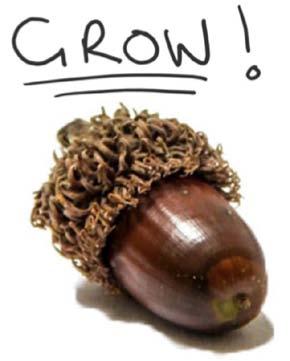
This model was coined by Max Landsberg, and originally publicised by John Whitmore. You can apply the model at any level. It can form part of the initial discussion between coach and learner and it can equally well be applied at a micro level of an individual skill within a lesson.
Goals: Spending time working out what the learner wants out of the lesson(s) or skill. They may not have given it too much thought so it might need teasing out. Get them to think about the timing relating to their goals; “How quickly do you need to be able to do all the Spey casts off both shoulders – to 120ft?”. It’s good to keep asking questions:
Learner: “I need to be able to cast further”
Instructor: “Why?”
Learner: “Because all the fish seem to move into the middle”
Instructor: “Why might that be?”
Learner: “Because I’ve scared them out there”
Instructor: “Why do you think that?”
Learner: “Because most of my casts to 40ft land heavily, or on their heads”
Instructor: “Ooohhh-kaaayy…”
Be careful not to try and shortcut this by imposing your own goals or trying to second guess their motivation. If the goals don’t represent what they really want they’re unlikely to commit effort to getting there.
Reality: This is where you discuss the distance between the goals and the learner’s current skill level.
22
LOOP, FALL 2021
THE
THE LOOP, FALL 2021
Coach Class continued ...
Again, this shouldn’t really be about you saying “Well, looking at your rubbish casts you’re about ten years away from where you want to be”. They need to tell you where they think they are. You can ask lots of questions and ask them to evaluate their own results. It’s a good idea to get them to notice their own results and to take ownership of them.
When discussing the reality, it’s important to be descriptive and NOT judgemental. Loops are not “good” or “bad”: they are “narrow” or “wide”; “smooth” or “wavy” etc. Judgemental descriptions create pressures and barriers to progress. Observations are factual and helpful.
As part of the reality discussion it’s a good idea to talk about the reality of their ability to commit. How often can they do a lesson? How often are they able to practice? What might get in the way? All this is focused on getting to practical solutions and learners need to recognise this early on.
At an individual skill level, the aim here would be to agree on current performance level and the reasons for it. “Can you describe what happens to the line as it is cast? What shape is the loop? Why do you think it is like that?”...etc
At a macro and micro level the aim is for the learner/coachee to build awareness of their current results and what they are doing that generates these results.
Everyday awareness of these things is generally very low. Learners have no idea what their loops are doing, they don’t know where the rod is going. Without being prompted they might not even be aware of their death-grip on the cork.
One of the best things a coach can do is to improve the awareness of the coachee. It’s amazing how focussing attention, in itself, can lead to better performance. If you ask a caster to really focus on where, in a single Spey, they lose feel and tension it’s amazing how they instantly keep tension all the way through and deliver a great cast!
This self-generated feedback is one of the big things that a coach aims for. It seems like magic, but this heightened awareness often generates an automatic self-correction.
Demand a high level of focus on what’s happening. Does anyone else notice how learners’ eyes seem fixed somewhere in the middle distance, on nothing in particular? When you ask them where the rod stopped, they have no idea. Get them to focus on specifics: the shape of the top-leg of the loop, the junction between fly line and leader, the path of the tip ring, the target.
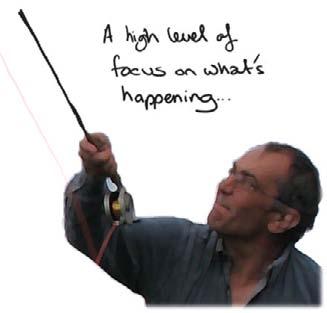
When asking coachees to describe what happened to get them to give descriptive not judgemental answers. All your questioning is directed at generating awareness and responsibility for moving forward. If they have to rely on you to see the fault they’ll rely on you to fix it and you won’t always be there.
Questions should follow the interests of the coachee, not yours. Let them find their own dead-ends! I’ve found this is really hard to do. Every fibre of my instructor-self is screaming “wait for the line to unroll!”.
23
THE LOOP, FALL 2021
Coach Class continued ...
Much better to ask them how long they think they should wait before starting the forward cast, and then ask them how they are going to calibrate this.
Options: This is a discussion about the different solutions that can close the gap between reality and their goals. In a pure coaching scenario the emphasis is on the person being coached being prompted to come up with their own solutions and options. Again the role of the coach is to ask questions:
“Given what you know about your current performance, what do you think you could change to improve?”
“If you knew the solution to this, what would it be?”
“What criteria are you using?”
“What is the hardest part of this for you?”
“What would you gain/lose by trying that?”
“What would be the consequences of trying that be for you?”
“What else?”
“What else?”
Way Forward: This is where you agree an action plan. Again this works at both a macro and micro level. At a macro level this might be agreeing a practice regime and future lesson plans. At a micro level it may be agreeing what you’re going to try next and for how long, and what will success look like.
At both levels you need get down to specifics of actions, timings, and dates.
When agreeing to actions remember to check back that these actions
are taking them towards their goals. If they aren’t, either the actions or the goals may need revisiting.
Good questions to ask around this are:
• What obstacles might you meet along the way?
• Who needs to know?
• What support do you need?
• How and when are you going to get that support?
• What other considerations do you have?
• Rate on a scale of 1-10, the degree of certainty that you will carry out the actions agreed? What prevents it becoming a 10?*
*Anything less than an 8 is a problem, and probably means they won’t do it, so you may need to adjust the plan.
Observing and Listening
Over the years I’ve mentored quite a few people wanting to become instructors. One of the key moments in their development is when their own observation and listening skills kick in. They move through three stages:
1. Unaware of their own casts and issues
2. Aware of their own casts and issues
3. Able to analyse and spot issues in other people’s casts
You can get to (2) and be a great caster, but if you can’t get to (3) you aren’t going to be a very good instructor or coach.
Over time, and with experience, these skills improve. Great instructors can see the whole cast, and the myriad small things that underpin it. Bruce Richards’ Six-Step Process is the bedrock here.
24
THE LOOP, FALL 2021
Coach Class continued ...
It amazes me how (even after introducing the Six-step process) you hear people reach a solution after seeing one unrolling loop, jumping from step one to step six in one massive leap!
Observation skills can only be built with practice and it’s the same with listening skills too. If you’re doing this right you’ll be asking lots of questions. Make sure you listen to the answers. This is harder than it may seem. Often we’re only half-way through listening to someone before we start formulating our response. When we’re doing this we’re not listening, so hang in there. Listening sits right alongside observation. What someone says is often tempered by body language and expression. Sometimes the words and body language don’t match and you have to be ready to pick up on this.
Instructor: “How are you feeling?”
Learner: “Yeah, I’m good” (whilst flexing their fingers and rubbing their shoulder…)
Feedback
Feedback has different uses and effects. At its most basic we are just telling the learner/coachee what just happened. The way we feedback can either help or hinder. Good feedback can unlock potential, poor feedback can demotivate and lock up that potential for a long time! If you’ve been paying attention you can probably guess what I’m going to say next: The ideal is that feedback is coachee-led, and that it is non-judgemental. The coach uses their questioning skills (there they are again!) to get the coachee to generate their own feedback. The primary purpose is to improve their self-awareness:
“What were you aiming to do there? To what extent do you think you achieved that?”
“What are the main points you’d make about that cast? Can you describe the loop? How did it land?”
“What else did you notice during that cast? What else?”
You can use video for feedback. Asking the coachee to review their own video (perhaps in comparison to a model video) works well. If the caster isn’t aware of what they did, you can ask them to repeat the cast, and just ask them to focus on what happens in a particular area. Note we’re not giving an instruction here:
“Do that cast again, and I want you to notice what happens to the top leg of the loop as it unrolls”
Then ask them what they noticed.
Again, awareness is king! If they can’t see their faults, they can’t fix them!
Some Final Thoughts
Since reading these books and looking into coaching I’ve tried to build these principles into my practice. It feels a bit seat-of-thepants to start with, but I’ve been amazed at how often it works. I did a club day once where I aimed to get through a two-hour session without giving any specific instruction. I failed and in some instances I floundered. But blimey! I was amazed at how much did work and how often I got casters to fix their own faults. It made the hairs stand up on the back of my neck.
When I first read Whitmore and Gallwey, I must own up to a level of ambivalence. On the one hand here were a bunch of concepts
25
THE LOOP, FALL 2021
Coach Class continued ...
which can really help me to help people improve their fly fishing. It’s fascinating to me that learners can often self-optimize without the need for direct instruction. On the other hand I was aware that I had just read a couple of instruction books on the principle of coaching without instruction. Irony!
The fact is that instruction is useful. We couldn’t have a primary and junior education system without it. There’s a lot of stuff which we have to teach where some level of instruction is essential. Imagine how long it would take to get a learner to “self-invent” a double haul.
As long as we understand the strengths and weaknesses of both disciplines we can look for the right balance. Too much direct instruction can lead to skills not being embedded properly, and demotivation. Too much coaching/exploration can mean that learners don’t have enough practical tools to achieve anything substantial.
The balance will change with the circumstances. Being aware of the needs of the learner, the nature of the learning environment, and the task at hand means we are more likely to find this balance.
So it is a balance. We need both instruction and coaching. Hurray! This means instructors no longer need to be sniffy about “coaches” who can’t cast to 100ft, and coaches no longer need to snipe about instructors as casting prima donnas who aren’t interested in realworld fishing. We can all just get along and learn from each other. I’m tearing up again.
IF YOU ARE INTERESTED WITH THE FFI CASTING INSTRUCTOR CERTIFICATION PROGRAMS
Please click these following links for further information on:
Casting Instructor Certification Program
CI, MCI, THCI and THMCI study materials
Click here to download
CI, MCI, THCI and THMCI Exams
Click here for further information on Next available CICP Exam dates.

CICP Exam in progress with two examiners, two EDP participants and an interpreter.
26
INDEX
THE LOOP, FALL 2021
HEAD BANGER
By Will Shaw
As Einstein famously didn’t say, “Insanity is doing the same thing over and over again and expecting different results.”
And as John McEnroe almost certainly did say “Life is a learning process and you have to try to learn what’s best for you. Let me tell you, life is not fun when you’re banging your head against a brick wall all the time.”
We’ve all been there eh? That cast just won’t do what it’s supposed to do. It’s short. It’s crumpled. It missed. So what do we do? As soon as the line settles we pick it up and try again. Same result. Try again. And again.
An hour later and you’re a mess. The cast is no better. Your arm hurts and you’re about to snap the rod in two and hurl it into the bushes. This is about as much fun as banging your head against that wall over and over again.
Why is this so hard? Why do I have a big bruise in the centre of my forehead?
Bad Habits
“It’s actually easier to teach a total beginner. They have no bad habits to unpick”. I’ve heard that a few times. Probably said it myself on numerous occasions. Usually after trying to fix a particularly egregious example of over-powering, creep, or both.
I get to do lots of lessons for people who’ve fished for donkey’s years and “just need a few wrinkles sorting out”. Often those “few wrinkles”
can amount to a full pile of ironing. When I started instructing, I would try and break their cast down and try and fix each element individually. This is hard!
Most times now I find it easier to forget about all the bad habits and try and build new ones instead. This can mean going right back to basics, usually some variation on Lee Cummings’ triangle method to build a solid foundation. This helps particularly in building good tip paths and power application.
With creep the least effective solution is to say “don’t let the rod creep forwards” or “don’t move the rod while the back cast is unrolling”. This is the trying to unpick bad habits approach – trying to get someone to stop doing something is hard.
The building new habits approach gives them something positive to do – and for me this is to get them to drift backwards. They are then focusing so hard on moving the tip back they completely forget to creep! It’s amazing how quickly this sorts out creep and the resulting power application issues.
So if you can find something positive for the learner to do, get them to do that rather than trying to stop them doing something bad. I worked that one out myself and I’m guessing most of you have too. But I have to say, effective as it is in the lesson, I do wonder how well it sticks. I wonder how deeply implanted the concept is and whether, without me standing next to them quietly saying “and… driiiiffft”, they’ll quickly go back to creeping and battering the heck out the forward stroke.
27
Head Banger
continued ...
Apparently other people have thought about this too and they’ve come up with a model for helping us with bad habits. This is called the Old Way – New Way approach (Lyndon, 1989).
Old Way - New Way
This is a three step process.
1. Preparation
This is where the learner learns to discriminate between the old way (bad habit), and the new way (solution). The coach supports the learner to break down the old way into its constituent parts to identify where the error or weakness lies.
The learner must be able to explicitly identify and label the Old Way. “Ah, I can see that I crept there and smacked the forward cast”.
2. Mediation
Here the learner gets to contrast the Old Way vs the New. They explicitly name and describe the commonality and differences between the two.
The aim is to get them to practice this five times. For example, they can comment on their own casts, or a video, or a demonstration. They should get progressively better at spotting the differences and
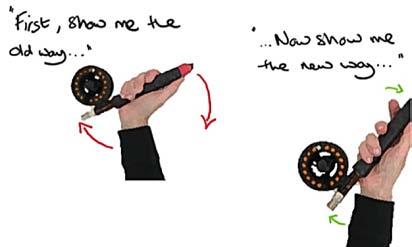
describing them as the exercise progresses. Stefan Siikavara from Sweden told me he’ll get students to demonstrate the fault: “show me a cast where you break your wrist badly” and then asks them to demonstrate a good cast. This is Stefan getting the student to contrast the Old Way and the New way.
3. Generalisation and Application
This is about building the habit of the New Way through repetition and practice.
This approach is, once again, about building awareness in the learner. As we said in the coaching article, if the learner isn’t aware of the problem they have no chance of fixing it. We can use the above methods and those outlined in our other articles in this series to heighten this awareness.
Old Way - New Way ends with us aiming to embed the New Way through practice. Sounds straight forward eh? Just get out there and repeat the good stuff until it’s ingrained. I wish it was that simple. Viewing practice as being solely about repetition is a brilliant way of taking us straight back to that brick wall and a bruised forehead. So how do we practice better?
Better Practice
If there’s one thing all instructors wish we could do, I’m guessing it would be to get learners to practice more between lessons. Imagine that? They’d come back with all the skills sorted from lesson one and be raring to go for the next level. But, in the UK at least, there’s a weird thing going on. People generally expect to be able to pick up a fly rod once or twice a year and be able to cast like Lefty.
28
LOOP, FALL
THE
2021
THE LOOP, FALL 2021
Head Banger continued ...
Sports types who can definitely see the benefits in spending time on a golf range or hitting back a tennis ball from a serving machine can’t see why they should spend half-an-hour a week in a field practising casting. Strange.
But even when learners are motivated to practice, they often don’t get the returns they expect. Good instructors will give learners exercises to do between lessons, hopefully with precise written instructions and advice as to how often and for how long they should be done. But often it’s tempting just to shortcut to saying “that’s great – you’ve got it! The main thing is now that you go away and practice this over and over again to build muscle memory”. I can hear myself saying these very words and this makes me cringe a little. This is because when we’re left to our own devices we often get practice wrong.
So we need to think about what good practice is.
In 1993 Swedish psychologist K. Anders Ericsson developed his theory of Deliberate Practice. His idea was that the elite performers in many fields were distinguished from average performers by how much Deliberate Practice they had done. Malcolm Gladwell picked up on this in his 2008 book Outliers – where he popularised the notion that you need to put in 10,000 hours to become a master of anything. The 10,000 hours thing has been questioned (including by Ericsson himself) but the idea of Deliberate Practice is still seen as valid.
Ericsson described several kinds of practice.
Naïve Practice
This is the most common kind of practice, where the idea is that repetition alone will lead to improvement. This can work but often the learner’s skills and motivation plateau quickly and motivation tapers off. This is an easy kind of practice to fall into. I’ve been amazed
when observing trainee instructors at practice. The rate of casting is phenomenal! The cast barely touches the water before the next cast is started. This is not only exhausting, it is really inefficient. There is no attempt to analyse what happened with the previous cast and no thought as to how to fix it. Head banging. Again.
Structured Practice
This is best typified by group practice, or team practice, where drills and activities are not tailored to individual learner’s requirements and goals.
Purposeful Practice
This is a big move in the right direction and is often the kind of practice to which the keener among us will gravitate. Purposeful practice is, for the most part, a solitary affair with the focused aim of improving particular skills with defined goals, monitoring, feedback and challenge. We may go out and spend an hour just working on anchor placement for our single Spey cast for example, or improving our accuracy. In this situation we are responsible for our own feedback and monitoring; many of us now use video. This kind of practice works well which is a bit of a relief given how much time I spend doing it!
Good instructors are using purposeful practice in lessons too. But it still doesn’t meet Ericsson’s definition of Deliberate Practice.
Deliberate Practice
Deliberate practice might be the least-used kind of practice. It is differentiated from other types of practice in the following ways.
1. It starts with an analysis to look for aspects of performance that will yield the greatest improvement.
29
Head Banger continued ...
2. It uses benchmarking. What is the standard? This means looking at experts, evaluating their performances, and understanding the drivers of that performance.
3. It quantifies the differences between current performance and the benchmark, and sets goals to close them
You can see right away that deliberate practice is going to take significantly more effort and planning. Ericsson specifies that Deliberate Practice is individualised to the specific learner and is guided and supported by a knowledgeable coach – you can’t do this stuff on your own. Research across all sports shows that not many instructors or coaches are using Deliberate Practice as defined by Ericsson. Recently Paul Ford and Edward Coughlan (2020) have developed their ASPIRE model for coaches to help bring Deliberate Practice to the fore. The following diagram is my attempt to summarise this model.
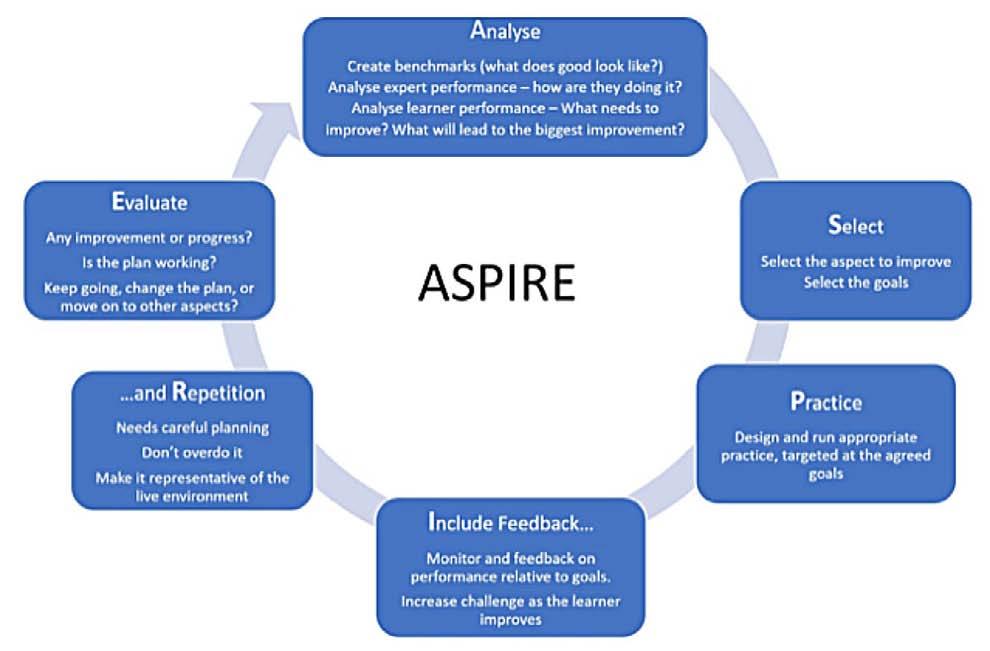
For me the big leap into Deliberate Practice is the “Analyse” stage. This is much more rigorous and detailed and will take time. Video analysis is invaluable here. You might need to review videos from multiple expert/elite casters to work out the benchmarks and understand the basis for technique, and then look at lots of footage of the learner’s
casts to work out the specifics of what you need to do. Quantifying performance and learning are things that need thought. Is it all about distance, or accuracy, or effort, or smoothness? You and the learner will need to decide.
30
THE LOOP, FALL 2021
Head Banger continued ...
I am struck by the similarity between the above and the GROW model outlined in the coaching article. Although GROW is in a slightly different order, I can see direct comparisons between the Analyse stage above and the Reality stage from GROW, and between the Select stage above and the Goals bit of GROW.
And again, there are parallels between Bruce Richards’ Six-step Process and both of these models. All three are grounded in observation and analysis. All of these models are there to make the instructor/coach think hard about what they are doing and rely less and less on off-the-shelf one-size-fits-all fixes.
Good instructors have solid foundations in technical understanding and the ability to demonstrate correct form and technique.
Really great instructors consistently work on improving learner’s self-awareness and have top-class observational and analysis skills and a complete absence of bruises on their foreheads.
References
Lyndon, H. 1989. Research into Practice. Australasian Journal of Special Education.
Ford, P.R. and E.K. Coughlan. 2020. Operationalizing deliberate practice in sport. In: Skill Acquisition in Sport, 3rd Edition, Hodges and Williams.
FLY CASTING INSTRUCTION FEATURED COLLECTION CONTRIBUTORS

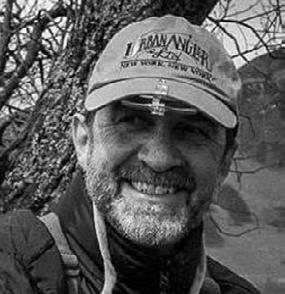
Mark Surtees. MCI based in London UK.
Member of EDP Faculty. Regular instructor for the British Fly Casting Club and a Judge for the 2018 World Fly Casting Championships.
Not fishing enough.
Will Shaw is based in the Scottish Borders and has been fly fishing for more than 40 years. He has fished for everything from trout to tuna and from pike to pollack. He has fly-fished all over the UK, the United States, Canada, Australia, the Pacific, and New Zealand.
As well as being the proud holder of the AAPGAI Advanced Single Handed qualification, he also holds Scottish Game Angling Instructor (SGAIC) in single handed and double handed, and FFI CI instructor qualifications.
Will has been involved with running the SGAIC course and qualification for instructors in Scotland since 2009.
31
LOOP, FALL
INDEX
THE
2021
NEW REGISTERED INSTRUCTORS
Newly Certified Instructors listed according to test date.
For incoming test date and other CICP events information, please visit:
http://flyfishersinternational.org/Casting/CalendarofEvents/tabid/616/Default.aspx
32 THE LOOP, FALL 2021 INDEX
First_Name Last_Name Home_City Home_Location Home_Country Test_Date Certi cations Tyler Bohannon Bozeman Montana United States 05/14/21 CI Stoddard Rowley Ketchum Idaho United States 06/21/21 CI James Carlin Ketchum Idaho United States 06/21/21 CI Joey Sides Hailey Idaho United States 06/21/21 CI Jill Clark Bellevue Idaho United States 06/21/21 CI Johnny Kamp Hailey Idaho United States 06/21/21 CI Brady Kallas Boise Idaho United States 06/23/21 CI James Higdon Cornelius North Carolina United States 08/20/21 CI Tony Brooks Hendersonville North Carolina United States 08/20/21 CI Rick Shelton Sterrett Alabama United States 08/20/21 CI Jim & Cari Vota Milford Ohio United States 08/20/21 CI Brian Esque Davidson North Carolina United States 08/21/21 CI Justin Burns Evans Georgia United States 08/21/21 CI Charles Abbott Ashburn Virginia United States 09/18/21 CI Carol Northcut Dillon Colorado United States 09/18/21 CI Terrence Cummings Ashburn Virginia United States 09/18/21 CI Scott Allen Herndon Virginia United States 09/18/21 CI Keith Bruce Denver Colorado United States 09/18/21 CI William Kopal Arvada Colorado United States 09/19/21 CI Brad Cleaves Phoenix Arizona United States 09/19/21 CI Kent Korgaard Hobro Jylland Denmark 10/05/21 CI Steven Morikawa Cloverdale California United States 10/13/21 THMCI Bue Poulsen Klarup Nordjylland Denmark 10/16/21 THMCI Merlin Pohlit Uppsala Uppsala Ian Sweden 10/16/21 CI Gary Turri San Ramon California United States 10/22/21 MCI Russ Carpenter Winters California United States 10/23/21 CI
The Editorial Team

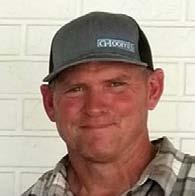

Jim Wigington, MCI, Editor-in-Chief, Redding, California USA. Jim is a retired research hydrologist who spent his career evaluating the effects of human activities on watersheds and streams. He has published in many scientific journals and previously was Editorin-Chief of the Journal of the American Water Resources Association. Currently, Jim is an active casting instructor and L-1 examiner.
Mac Brown, MCI, is the owner of Mac Brown Fly Fish and Fly Fishing Guide School in Bryson City, NC. He is the author of Casting Angles and contributor to numerous magazine articles. Mac will serve as a technical advisor for the Loop. He enjoys adventure travel with his family when not teaching fly fishing techniques.
Peter Morse MCI is a professional Australian fly fisherman of many years who fishes in all waters for all species without prejudice. He is the author of countless magazine stories and 3 books, as well being a television presenter and script writer.

Bruce Richards, MCI, Montana, USA, designed many great lines for Scientific Anglers and wrote the seminal work, Modern Fly Lines. He is a former chair of CBOG and was instrumental in the development of the Casting Instructors’ Certification Program (CICP). All correspondence to be addressed to: loop@flyfishersinternational.org - Website: http://flyfishersinternational.org/ Copyright © 2021, Fly Fishers International (FFI) The

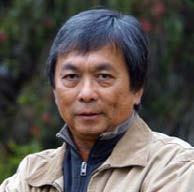
Paul Brown, MCI, THMCI & L-1 Examiner, England. Paul is also a member of the UK’s Game Angling Instructors’ Association (GAIA) and holds the Advanced Professional Game Angling Instructors’ qualification (APGAI) in both double-handed and single-handed and is also a qualified GAIA Mentor and Assessor. Paul is a published author of children’ books, he also has 30 years media experience with some of the best ad agencies in England.
Bintoro Tedjosiswoyo is a CI & THMCI who lives in Melbourne, Australia. Bintoro is a commercial graphic designer and illustrator, he is The Loop’s graphic design editor and illustrator.
33 THE LOOP, FALL 2021 INDEX
Loop and the individual contributors. All materials contained in this publication are protected by United States copyright law and may not be reproduced, distributed, transmitted, displayed, published or broadcast without the prior written permission The Loop and the author or contributor of that content. However, you may download material from The Loop for your personal, noncommercial use only. Links to Web sites other than those owned by the FFI are offered as a service to readers. Neither the FFI nor the editorial staff of The Loop was involved in their production and they are not responsible for their content.
































